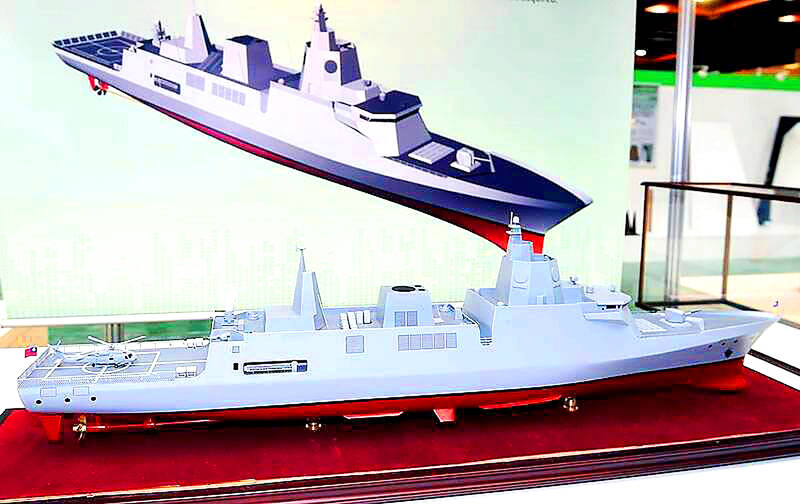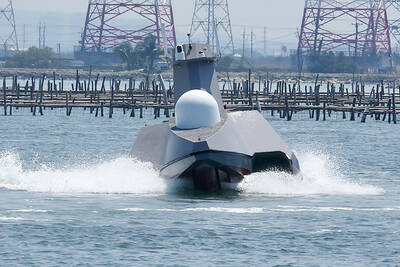The navy has resumed work on developing a new 6,000-tonne guided missile frigate equipped with a US-made radar system, a source said on Saturday.
The project had been halted, but the military has identified a need for a new generation of guided missile frigates equipped with active phased array radars to support maritime defenses, the source said.
The ship’s tonnage was increased from 4,500 tonnes to 6,000 tonnes, and it would use the US-made AN/SPY-7 active phased radar system from defense contractor Lockheed Martin Corp, they said.

Photo: Taipei Times
“The initial plans had called for a passive radar system, but that was later changed to an active system in line with international shipbuilding trends,” the source said.
“Due to the changes in tonnage and radar design, the project was halted, and the budget was used to design two different light frigates,” they added.
However, in April last year, officials announced that the project for the larger frigate would be restarted, with plans for the design to be finalized by next year.
The guided missile frigate and the two lighter ships all have different uses and would complement each other, they said.
“The light frigates are to be used for air defense and anti-submarine missions, and are to be delivered in the third quarter of 2026,” the source said.
The guided missile frigate would use domestically developed Huayang air defense missile vertical launch systems, designed specifically for Taiwan’s Hai Kung III (Sea Bow III) missiles, the source said, adding that the missiles would be used for fleet air defenses and local missile intercepts.
Taoyuan Department of Economic Development Director Chang Cheng (張誠), former chief engineer on the Hsiung Feng III (Brave Wind III) missile project, previously said that the AN/SPY-7 system is on the same technical level as the AN/SPY-6(V) radar system developed by US defense contractor Raytheon Co.
Both systems were submitted as bids to the US Navy, which ultimately chose the Raytheon system, and Lockheed’s system was produced exclusively for export, Chang said.
The AN/SPY-7 radar system has an open architecture design that can be easily modified to suit countries’ different naval warships, he said.
“The system has been adopted by Spain, Canada and Japan, and is considered an upgraded version of the Aegis Combat System used in South Korea, Norway, Australia and other countries,” Chang said.
In terms of tonnage, ships that use the AN/SPY-7 include the 6,100-tonne Spanish F110 frigate, the 7800-tonne Canadian Surface Combatant, and the 8,200-tonne Japanese Maya-class destroyer Haguro.

ENDEAVOR MANTA: The ship is programmed to automatically return to its designated home port and would self-destruct if seized by another party The Endeavor Manta, Taiwan’s first military-specification uncrewed surface vehicle (USV) tailor-made to operate in the Taiwan Strait in a bid to bolster the nation’s asymmetric combat capabilities made its first appearance at Kaohsiung’s Singda Harbor yesterday. Taking inspiration from Ukraine’s navy, which is using USVs to force Russia’s Black Sea fleet to take shelter within its own ports, CSBC Taiwan (台灣國際造船) established a research and development unit on USVs last year, CSBC chairman Huang Cheng-hung (黃正弘) said. With the exception of the satellite guidance system and the outboard motors — which were purchased from foreign companies that were not affiliated with Chinese-funded

PERMIT REVOKED: The influencer at a news conference said the National Immigration Agency was infringing on human rights and persecuting Chinese spouses Chinese influencer “Yaya in Taiwan” (亞亞在台灣) yesterday evening voluntarily left Taiwan, despite saying yesterday morning that she had “no intention” of leaving after her residence permit was revoked over her comments on Taiwan being “unified” with China by military force. The Ministry of the Interior yesterday had said that it could forcibly deport the influencer at midnight, but was considering taking a more flexible approach and beginning procedures this morning. The influencer, whose given name is Liu Zhenya (劉振亞), departed on a 8:45pm flight from Taipei International Airport (Songshan airport) to Fuzhou, China. Liu held a news conference at the airport at 7pm,

AIR SUPPORT: The Ministry of National Defense thanked the US for the delivery, adding that it was an indicator of the White House’s commitment to the Taiwan Relations Act Deputy Minister of National Defense Po Horng-huei (柏鴻輝) and Representative to the US Alexander Yui on Friday attended a delivery ceremony for the first of Taiwan’s long-awaited 66 F-16C/D Block 70 jets at a Lockheed Martin Corp factory in Greenville, South Carolina. “We are so proud to be the global home of the F-16 and to support Taiwan’s air defense capabilities,” US Representative William Timmons wrote on X, alongside a photograph of Taiwanese and US officials at the event. The F-16C/D Block 70 jets Taiwan ordered have the same capabilities as aircraft that had been upgraded to F-16Vs. The batch of Lockheed Martin

GRIDLOCK: The National Fire Agency’s Special Search and Rescue team is on standby to travel to the countries to help out with the rescue effort A powerful earthquake rocked Myanmar and neighboring Thailand yesterday, killing at least three people in Bangkok and burying dozens when a high-rise building under construction collapsed. Footage shared on social media from Myanmar’s second-largest city showed widespread destruction, raising fears that many were trapped under the rubble or killed. The magnitude 7.7 earthquake, with an epicenter near Mandalay in Myanmar, struck at midday and was followed by a strong magnitude 6.4 aftershock. The extent of death, injury and destruction — especially in Myanmar, which is embroiled in a civil war and where information is tightly controlled at the best of times —